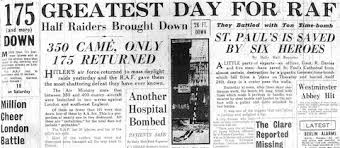Since last week of August 1940 , Luıftwaffe air raids focused on RAF fighter aerodomes on South East England and damaged five airfields very heavily. RAF fighter pilots in this sector belonging Group 11 were exhausted , their casaulties heavy though they gave as much as they got to enemy also. On 7th September Luftwaffe suddenly shifted focus of attack by Hitler’s lifting on ban of British capital the day before. Between 7-13 Sepember Luftrwaffe bomber groups started massive raids on London , sratring huge fires , killing more than 1.000 civilians. But meanwhile RAF Fighter Command pulled together its strength after two weeks of savage fighting over SW England over its own airfields and sector stations. Luftwaffe Commander in Chief Reichsmarshall Goring and Luftflotte commanders Sperle and Kesselring in a strain of over optimism assumed that all RAF fighter reserves were destroyed (“Goring claiming that RAF Fighter Command was down to 50 Spitfires”) After a week of this pounding, Churchill traveled to the headquarters of the 11th Fighter Group, the unit responsible for the defense of the air over London and southeastern England.
This was not a random call — he knew from “Ultra” intelligence intercepts that almost all the German bombers based in France were to fly against London that day, and he knew from previous visits that summer that 11th Group’s command post was the best location from which to monitor such a fight. Just two weeks earlier there had been a dogfight in the skies above it.
The day of Churchill’s visit, September 15, would prove to be one of the fiercest days of aerial combat in the entire campaign. He would later recall the day as “the culminating date” of the Battle of Britain.
It was a Sunday morning. At the 11th Group headquarters, located on the western fringe of London, he descended some fifty feet into the bunker containing the group’s operations room and watched Air Vice Marshal Keith Park, commander of the fighter group, pace the room and issue orders, sending squadrons into combat. Soon RAF Fighter squadrons began to rise up and began to engage Luftwaffe formations that were being tracked by radars over France and Channel.
A giant display board, the width of the room, covered one wall, keeping track of each of the Fighter Group’s twenty-five squadrons. A series of lights recorded the state of each unit — those on standby, those aloft, those that had sighted the enemy, and finally, at the top, red lights for those “Engaged” — that is, in action.
Light after light turned red. Soon Park had thrown all his assigned aircraft into the fight. This meant that soon all the squadrons would start landing to refuel. That would be a moment of great concern, because of the risk of the aircraft bunched on the ground being hit by German planes, which could cause intolerable losses. Park contacted his commander to request that he be allowed to use the three squadrons still in reserve. Close to two hundred German warplanes were in the air over southeastern England.
Churchill, unable to contain himself any longer, asked Park, “How many more have you got?”
None, Park replied — “I am putting in my last.” Park later wrote that at hearing this, Churchill looked “quite grave.”
He was indeed, because he realized, as he put it later, that “the odds were great; our margins small; the stakes infinite.” For fifty minutes, there were no more British fighters available. Just four months earlier, Churchill had winced when he heard French leaders use a similar phrase about their lack of a reserve force. Their defeat had come not long after. As the Battle of Britain got under way, he had mused, “What a slender thread the greatest of things can hang by.” Now he was seeing Britain’s thread stretched almost to the breaking point.
But the British, unlike the French, would hold. The Spitfires and Hurricanes had to refuel, but the Germans had to as well — and they had to go much farther to do it. So another wave of raiders did not come, and the British fighters were not caught flat-footed on the ground while refueling. All RAF fighters both in Group 11 and Group 12 joined in and intercepted closing German formations.
Yet thousands of German bombs dropped that day, including two that hit Buckingham Palace, likely by mistake. A bailed out Grman pilot from his stricken aircraft over London was almost lynched by mob at train station. The RAF lost 26 aircraft in the day’s fighting but downed 56 German aircraft, for an impressive kill ratio of two to one. (five more Luftwaffe aircraft crashed down on shores of France , too damaged to fly anymore. So day’s tally was 61 German aircraft shot down in exchange of 26 RAF fighters-half of shot down RAF fighter pilots bailed out and parachuted safely although British newspapers for sake of public morale claimed 185 enemy aircraft shot down) As Churchill departed the bunker, the “All Clear“ sounded. Churchill went to the prime minister’s official country residence, Chequers, walked straight to his room, and lay down to sleep for about four hours.
At the other side of hill , Goring was pissed , he blamed Luftwaffe fighter pilots not accomplishing their mission and accused them with cowardism in face of enemy. Kesselring and Sperle were confused , first time , RAF was attacking in big formations. Not just in physical but in also morale sense 15th September was turning point of Batle of Britain and displayed clearly that Luftwaffe , not designed and equipped for strategic operations anyway , was failing against a determined air defence system.

